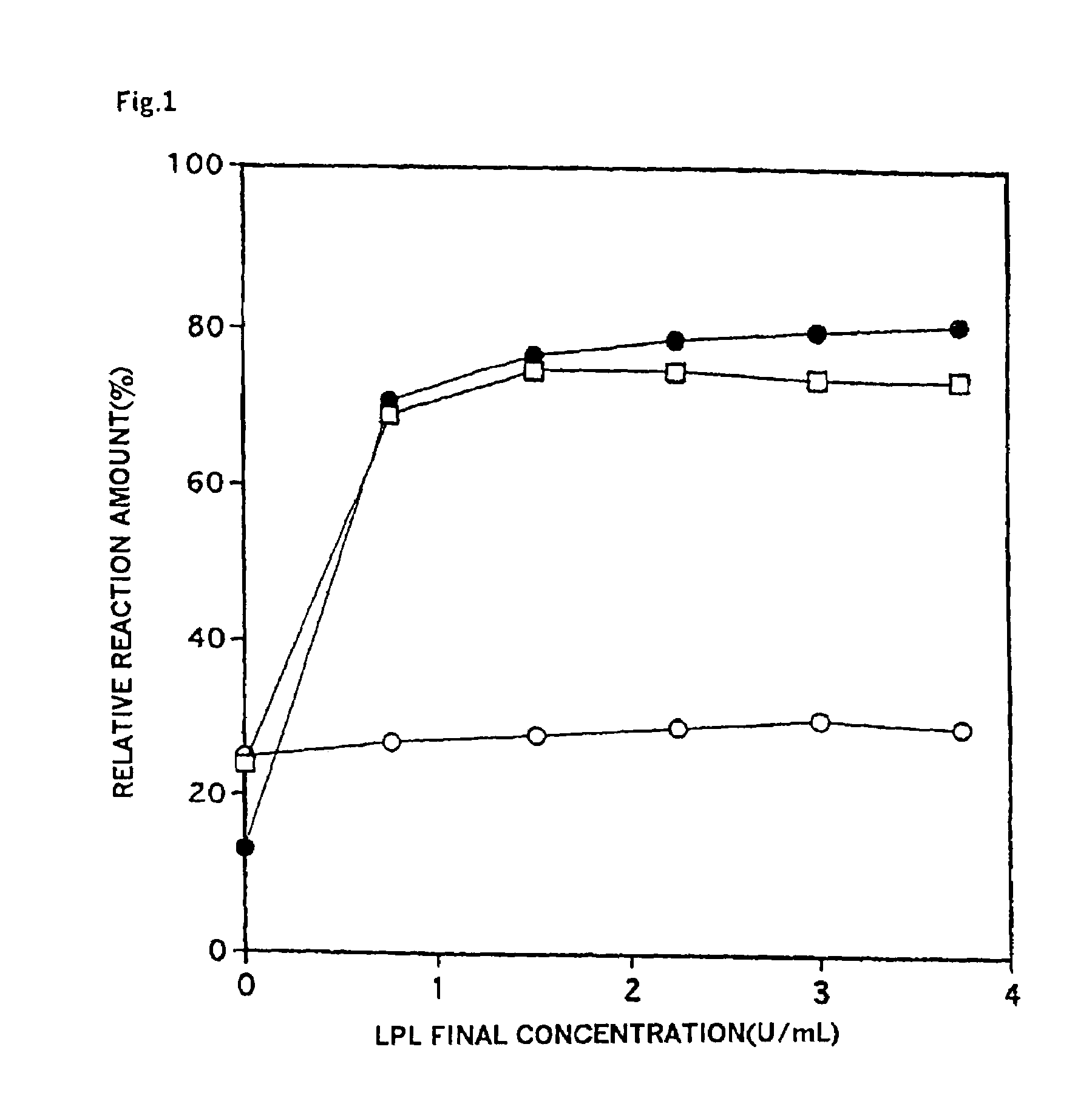Reagent set and method for detecting cholesterol in a high-density lipoprotein or low density lipoprotein
a high-density lipoprotein, low-density lipoprotein technology, applied in the direction of enzymes, multi-enzyme systems, biochemistry apparatus and processes, etc., can solve the problems of many specimens that cannot be treated in short time, low speed, and inability to perform assay simultaneously with the assay of other general biological items
- Summary
- Abstract
- Description
- Claims
- Application Information
AI Technical Summary
Benefits of technology
Problems solved by technology
Method used
Image
Examples
example 1
[0043]The following reagents were prepared. As specimens serum 10 sampled from ordinary people were used. The assays were practiced on a Hitachi 7170 Type automatic analyzer. The operational method was as follows. First, to 5 μL of each specimen was added with 180 μL of reagent 1-A, -B or -C, and kept in a constant temperature at 37° C. for 5 minutes. At this point of time, absorbance 1 was measured at a main wavelength of 340 nm and a side wavelength of 570 nm, respectively. Furthermore, 60 μL of reagent 2 was added, and kept in a constant temperature at 37° C. for 5 minutes. At this point of time, absorbance 2 was measured at a main wavelength of 340 nm and a side wavelength of 570 nm, respectively. A difference between the absorbances 1 and 2 was obtained and the value of each specimen was converted using a control, whose HDL-cholesterol concentration was already known, as a standard solution. As a control method, a polyethylene glycol (PG) method was used. In the PG method, PG p...
example 2
[0046]The following reagents were prepared. As specimens serum 10 sampled from ordinary person were used. The assays were practiced on a Hitachi 7170 Type automatic analyzer. The operational method was as follows. First, to 3 μL of each specimen was added with 210 μL of reagent A-1, and kept in a constant temperature at 37° C. for 5 minutes. At this point of time, absorbance 1 was measured at a main wavelength of 340 nm and a side wavelength of 570 nm, respectively. Furthermore, 70 μL of reagent A-2 was added, and kept in a constant temperature at 37° C. for 5 minutes. At this point of time, absorbance 2 was measured at a main wavelength of 340 nm and a side wavelength of 570 nm, respectively. A difference between the absorbances 1 and 2 was obtained and the value of each specimen was converted using a control, whose HDL-cholesterol concentration was already known, as a standard solution. Reagents B-1 and B-2 were used in the same manner as above. The values by the control method we...
example 3
Experiment Examples
[0049]The following reagents were prepared and the effects of each factor were studied in Experiments 1 to 4. As specimens, HDL, LDL and VLDL fractions were used, which were obtained by pooling serum 10, sampled from ordinary person, and followed by ultracentrifuge. The assays were practiced on a Hitachi 7170 Type automatic analyzer. The operation method was as follows. First, to 5 μL of each specimen was added with 180 μL of reagent 1-D, -E, -F, or -G, and kept in a constant temperature at 37° C. for 5 minutes. At this point of time, absorbance 1 was measured at a main wavelength of 340 nm and a side wavelength of 570 nm, respectively. Furthermore, 60 μL of reagent 2-D, -E, -F or -G corresponding to reagent 1-D, -E, -F, or -G, respectively, was added, and kept in a constant temperature at 37° C. for 5 minutes. At this point of time, absorbance 2 was measured at a main wavelength of 340 nm and a side wavelength of 570 nm, respectively. A difference between the abs...
PUM
| Property | Measurement | Unit |
|---|---|---|
| concentration | aaaaa | aaaaa |
| concentration | aaaaa | aaaaa |
| constant temperature | aaaaa | aaaaa |
Abstract
Description
Claims
Application Information
 Login to View More
Login to View More - R&D
- Intellectual Property
- Life Sciences
- Materials
- Tech Scout
- Unparalleled Data Quality
- Higher Quality Content
- 60% Fewer Hallucinations
Browse by: Latest US Patents, China's latest patents, Technical Efficacy Thesaurus, Application Domain, Technology Topic, Popular Technical Reports.
© 2025 PatSnap. All rights reserved.Legal|Privacy policy|Modern Slavery Act Transparency Statement|Sitemap|About US| Contact US: help@patsnap.com



